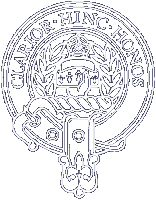
Clan Buchanan

History
The Buchanan name has been grounded in the lands surrounding the shores of Loch Lomond since 1225, when a grant by the Earls of Lennox to Sir Absalon of Buchanan, referred to in contemporaneous sources as clericus meus i.e. he was a clergyman. But the Buchanan clan is thought to have originated in 1016 A.D. when Anselan O'Kyan (or Absalon) fled Ireland. He was the son of the reigning Ulster monarch and was forced to flee Ireland by Canute the Dane. He was then employed by Malcom II (the Scottish king) to defend against Norse attacks in the west. He was awarded land (through marriage into the family of the Earl of Lennox) on the east bank of Loch Lomond. The Buchanan lands lying to the east of Loch Lomond, remained in the clan for nearly seven centuries. The lands and the Buchanan House were sold in 1682 to the 3rd Marquess of Montrose on the death of John, the 22nd laird. Despite the number of cadet branches, the clan became dispersed.The derivation of the name in Gaelic lends validity to such a claim: Buth chanain is Gaelic for the "House of the Canon," an indication that the first Buchanan's may have been a family that was dedicated to the service of the ancient Celtic church, or may have had a pre-charter, hereditary clerical tenure. Furthermore, the clan can trace its origins back to Anselan O Kyan, son of a King of Ulster who landed in Argyll circa 1016. For his services against the Danes he received the lands of Buchanan, lying to the east of Loch Lomond.
Buchanan Castle stands on that land today, although it was built and owned by the Montrose family. It is now surrounded by a golf course, Club Buchanan Castle. The clubhouse sits on the former grounds of Buchanan house.

Buchanan Castle 1990.
The Buchanan clan has one of the oldest established clan societies in Scotland, which owns the clan's most precious possession, its heartland from which it gets its warcry. This is a small island, measuring just half a mile in length, named Clar Innis or Clarinch, on Loch Lomond. It is on this island that the clan was first recorded in 1225. That was when the island was given to Sir Anselan of Absalon of Buchanan, said to be a son of Macbeth.
Equally, it has been argued that the benefactor was Gilbert, seneschal to the Earl of Lennox, and that the lands were in Stirlingshire. 1282 was when these lands were confirmed with baronial rights through a charter to Morris of Buchanan, who also held a small island called Clarinch, that subsequently became the clan battle cry.
The Buchanans supported the Bruce in the war of independence, thus assuring the predominance of the family in the post-Banockburn era. The Buchanan shield is virtually indistinguishable from the Royal Arms of Scotland, with a significant difference. The Buchanan version of the arms changes the lion and the double treasure of fleur de lis from red to black, thought to be an allusion to the marriage of Sir Walter Buchanan to the only daughter of Murdoch, Duke of Albany and Regent of Scotland.
The regent was to be beheaded by his cousin, James I in 1425, his lands confiscated and the line of the Regent's family terminated when his son died heirless. It is reputed that the colouring of the Buchanan arms also reflects a mourning for loss of status as nearest relatives to this branch of the disinherited family.
Other descendants of this chiefly family were the Buchanan's of Arnprior who held lands in Kippen, Perthshire, where they were known as 'Kings of Kippen'. This popular nickname relates to a Walter Scott story in which James V arrived at Arnprior, unrecognised due to his penchant for travelling his lands in disguise. He was met with a degree of hospitality that was hardly sufficient given his status - the Laird was eating, and could not be disturbed, he was told.
The disguised James V asked the Laird's doorman to tell the 'King of Kippen' that:
"... the Goodman of Ballengreich is come to feast".
Buchanan knew that these words signalled he was in the presence of true royalty, and begged forgiveness.

